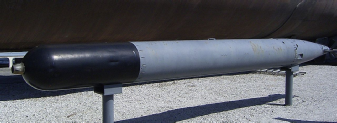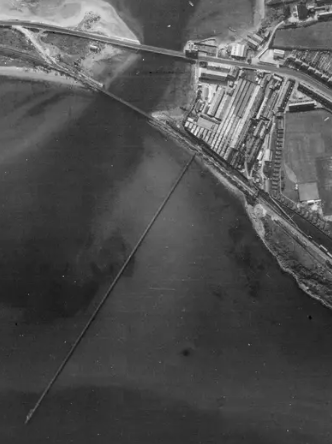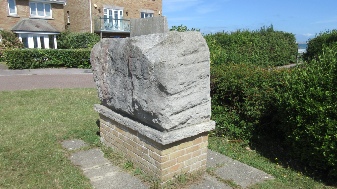Chesil Beach and the Fleet Lagoon
18 miles and 180 billion pebbles
Ferrybridge - Whiteheads

The Whiteheads torpedo works were located adjacent to the main Weymouth-Portland road at the southern end of Wyke Regis. They occupied the land between the road and the Portland Harbour shoreline on the north side of the Fleet. The area is now a housing estate.
Robert Whitehead was a british-born engineer from Lancashire who took a job in marine engineering in Marseille in France. He then worked for a company building warships in Fiume in Italy. In 1864 he became interested in attempting to remotely fire an underwater charge and in 1868 successfully demonstrated a workable torpedo. By 1889 he had a practical design for an 18 inch torpedo which he demonstrated to the Royal Navy. The Royal Navy ordered a batch of torpedoes but Whitehead was advised to set up a manufacturing base in the UK if he wanted subsequent orders.
Portland Harbour was already being used to test torpedoes and being sheltered by the newly-constructed breakwaters it was an obvious choice to place the new factory. The site chosen had access from a main road, a railway line and the sea. The foundation stone was laid in 1891 and was completed within a year. The factory included various workshops and a long pier extending into Portland Harbour. The works included various railway sidings.
The early torpedoes were either 14 inches or 18 inches in diameter and could reach speeds of 20 knots. From 1895 they included a gyroscope which gave much increased bearing accuracy.
In 1902 Robert Whitehead died and ownership of the works passed to the Vickers and Armstrong-Whitworth companies. During WW1 the factory was controlled by the Admiralty and was in continuous production for most of that period. Following the end of the war the demand for torpedoes plummeted and in 1921 the Whitehead company had ceased trading and the workforce sacked.
A new company was formed by Vickers-Armstrong in 1923 and production was re-started. In 1934. With war with Germany looming, the factory embarked on a major modernisation programme. By now the torpedoes had standardised on 21 inch diameter, were powered by compressed air and could reach a speed of 50 knots.
In the early days of WW2 the plant came under attack from enemy aircraft. Although most of the bombs missed the factory, the assembly shop was hit and sustained significant damage. Following the raids the decision was made to disperse torpedo production to three additional sites away from Weymouth and this was achieved by the end of 1942.
Following the end of WW2 the demand for torpedoes dropped considerably and the factory had to diversify to win work to continue in business. It still retained an interest in torpedoes and worked with the Admiralty research teams to develop wire-guidance and rocket propulsion for torpedoes.
However, production methods were changing and some traditional skills were no longer needed resulting in the gradual close-down of parts of the works. By 1960 the works were specialising in hydraulic equipment and the final torpedo order was completed in 1966.
In 1966 it was announced that the hydraulics work would be transferred to Swindon and the factory put up for sale. Wellworthy Ltd purchased the site and production of parts for the car industry started. Some of the old buildings were demolished and replaced with more modern units. The long pier out into the harbour was demolished in 1968.
In 1986 another name change occurred to AE Piston Products. However, The production was moved to other sites and the factory closed in 1997 and put up for sale in 1998. It was purchased by a developer who demolished the site and built a housing development called ‘Harbour Point’ The main road into the estate was named Whitehead Drive. A nearby road is named Gallwey Road after the first plant manager.

The MK VIII torpedo was the main torpedo used during WW2. Over 3000 were fired during this conflict. It remained in service until 1990 and notably was used during the Falklands war.

The Whitehead factory in 1946. The road and railway bridges are to the left of the factory and the long pier out into deeper water is below. The railway siding is to the right of the factory buildings.

In 1997 the site has been cleared ready to build houses. The railway has gone and the road is on a new bridge.
For more information about the Whitead works there is a long article in a book by Doug Hollings: ‘All about Ferrybridge’.

The memorial stone on the site of the Whiteheads factory. Unfortunately the text is almost unreadable today.




